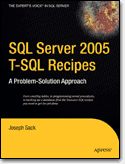 SQL Server 2005 T-SQL Recipes: A Problem-Solution Approach
SQL Server 2005 T-SQL Recipes: A Problem-Solution ApproachThis book has been published it is 768 pages and published by Apress and you can order it from amazon
You can download chapter 6 here to get a feel for the book
Need to brush up on specific SQL Server tasks, procedures, or Transact-SQL commands? Not finding what you need from SQL Server books online? Or perhaps you just want to familiarize yourself with the practical application of new T-SQL–related features. SQL Server 2005 T-SQL Recipes: A Problem-Solution Approach is an ideal book, whatever your level as a DBA or developer.
This “no-fluff” desk reference offers direct access to the information you need to get the job done. It covers basic T-SQL data manipulation, the use of stored procedures, triggers and UDFs, and advanced T-SQL techniques for database security and maintenance. It also provides hundreds of practical recipes that describe the utilities of features and functions, with a minimim of background theory.
Additionally, this book provides “how-to” answers to common SQL Server T-SQL questions, conceptual overviews, and highlights of new features introduced in SQL Server 2005. It also features concise T-SQL syntax examples, and you can use the book to prepare for a SQL Server-related job interview or certification test.
Below is the table of contents
CHAPTER 1 SELECT
CHAPTER 2 INSERT, UPDATE, DELETE
CHAPTER 3 Transactions, Locking, Blocking, and Deadlocking
CHAPTER 4 Tables
CHAPTER 5 Indexes
CHAPTER 6 Full-Text Search
CHAPTER 7 Views
CHAPTER 8 SQL Server Functions
CHAPTER 9 Conditional Processing, Control-Of-Flow, and Cursors
CHAPTER 10 Stored Procedures
CHAPTER 11 User-Defined Functions and Types
CHAPTER 12 Triggers
CHAPTER 13 CLR Integration
CHAPTER 14 XML
CHAPTER 15 Web Services
CHAPTER 16 Error Handling
CHAPTER 17 Principals
CHAPTER 18 Securables and Permissions
CHAPTER 19 Encryption
CHAPTER 20 Service Broker
CHAPTER 21 Configuring and Viewing SQL Server Options
CHAPTER 22 Creating and Configuring Databases
CHAPTER 23 Database Integrity and Optimization
CHAPTER 24 Maintaining Database Objects and Object Dependencies
CHAPTER 25 Database Mirroring
CHAPTER 26 Database Snapshots
CHAPTER 27 Linked Servers and Distributed Queries
CHAPTER 28 Performance Tuning
CHAPTER 29 Backup and Recovery
3 comments:
I saw your site from blogexplosion.com and I would like to ask if you have read the book . I am kind of a beginner in T-SQL and I could use some help and your opinion !!! Is it a good book to begin with ?
Thanks
kanenas.net
I have not read the book yet but have ordered it from amazon
If you have SQL server 2000 experience you could try the following book
Pro SQL server 2005
If you are new to T-SQL try this one Beginning Transact-SQL With SQL Server 2000 and 2005
Thank you so much !!!
kanenas.net
Post a Comment